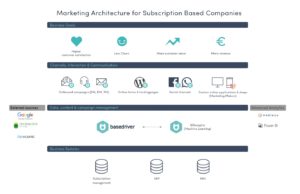The marketing architecture is one of the succesfactors for succesful modern marketers. There are plenty of tools that can help marketers improve their website, campaigns or other expressions. They are often based on data and more and more they work with the help of artificial intelligence.
When we speak with clients, we often get the question how these tools relate to each other. What is the ideal mix where you use new technology but do not pay too much? With these types of questions it is useful to create a marketing architecture for your company. In such an architecture you can draw the different applications so that you get immediate insight into the (im) possibilities and the overlap.
The example image below shows an example of such an architecture, in this case for companies that sell subscriptions.
The marketing architecture starts with goals.
Everything that has to do with marketing must start and end with customers. That is why the top layer of a marketing architecture also consists of goals that are directly related to customers. In the example, these are goals such as customer satisfaction, revenue per customer and fewer cancellations (churn). It is essential to determine which goals you want to achieve. If you mainly have an acquisition target (new customers), then you need completely different systems than when retention (customer retention) is your main objective. The goals largely determine the order in which the marketing architecture is completed.
Business applications in the marketing architecture
If you are not a start-up, you are probably dealing with business applications such as PIM (product information), ERP (resource planning) or, in our example, subscription management. These applications contain data that you need for your marketing and sales activities, but they are not suitable for marketing. Certainly for companies that have been around for a while, these applications are of vital importance and are not simply replaced; so we will have to find a way to work with it. They are a prerequisite for success.
When we have determined the goals and know what the business applications are, we can continue to fill in the marketing architecture. Therefore we have defined three layers.
Interaction layer
The interaction layer of the marketing architecture consists of the applications that interact directly with the customer. We are talking about the shop, the website, e-mail marketing software and social media managers, but also about software used by call center agents to make offers. When you select an application in this layer, you have to pay particular attention to three things: the flexibility to make adjustments and improvements, the extent to which you can measure results and the extent to which you can link to systems from the underlying layer.
Content and campaigns
The layer below the interaction layer is the primary domain of the marketers. Content and campaigns are created in this layer, which are then distributed via the interaction channels. By putting content and campaigns in one layer it is possible to use the same content and the same campaigns in different channels, for example by also using the offer that a customer receives by e-mail in the call center. User-friendliness for the marketer is important in this layer; you want to be in control yourself. It is also important that you choose systems that contain a high degree of business ruling and automation; you want to avoid as much manual work as possible.
Data and insights
Data is needed in the marketing architecture to show the right campaigns and content to the right person. This data comes mainly from the business systems, but can come from countless different other sources. In this layer you choose applications that are able to access different data sources, merge profiles and duplicate profiles. This creates a basis of qualitative data that you can use to create the right campaigns and personalizations. In addition to data, there is also room in this layer to create insights and add them to the profile. This can be done through data analysis, but also through machine learning. In the example we generate insights about the chances of cancellation (churn profile) through machine learning and add it to the profile, so that marketers can use those insights for campaigns.
Step-by-step approach to a marketing architecture
As an observant reader you have probably seen that the architecture in the example does not contain all layers. The campaign, content and data layers are merged in this example. In a marketing architecture it is possible to merge layers if the situation requires it. For example, many companies start with the interaction layer: a webshop and an e-mail service provider that are directly linked to each other. If it becomes difficult over time to keep all data in sync, duplications occur or not all systems can be unlocked, it is wise to fill in the data layer. If you notice that you want to use multiple channels and you spend more and more time setting out and coordinating campaigns across different channels, then it is time to complete the campaign and content layer.
One last tip. Do you feel that too many different marketing applications are already being used in your organization? Then draw them in the different layers. You can immediately see where the overlap is and where the opportunities lie.
More information regarding a marketing automation architecture with Basedriver?
If you would like to know more regarding a marketing automation archictecture with Basedriver, please contact us and we are happy to schedule an appointment.
This post is also available in:
 Nederlands (Dutch)
Nederlands (Dutch)









